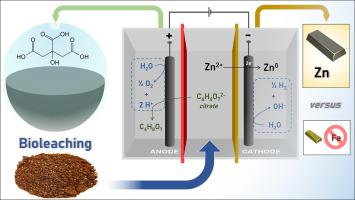当前位置:
X-MOL 学术
›
Hydrometallurgy
›
论文详情
Our official English website, www.x-mol.net, welcomes your
feedback! (Note: you will need to create a separate account there.)
Conjoint bioleaching and zinc recovery from an iron oxide mineral residue by a continuous electrodialysis system
Hydrometallurgy ( IF 4.8 ) Pub Date : 2020-08-01 , DOI: 10.1016/j.hydromet.2020.105409 Adam J. Williamson , Karel Folens , Kylian Van Damme , Oludotun Olaoye , Thomas Abo Atia , Bernd Mees , Nina Ricci Nicomel , Florian Verbruggen , Jeroen Spooren , Nico Boon , Tom Hennebel , Gijs Du Laing
Hydrometallurgy ( IF 4.8 ) Pub Date : 2020-08-01 , DOI: 10.1016/j.hydromet.2020.105409 Adam J. Williamson , Karel Folens , Kylian Van Damme , Oludotun Olaoye , Thomas Abo Atia , Bernd Mees , Nina Ricci Nicomel , Florian Verbruggen , Jeroen Spooren , Nico Boon , Tom Hennebel , Gijs Du Laing

|
Abstract Many metal refining processes generate low-grade mineral residues that are typically stored on landfills and responsible for inefficient land-use. While being of environmental concern, residual metals contained in these wastes can become an interesting secondary resource. A novel bio-hydrometallurgical route for recovery of Zn from such waste residues to a highly pure resource is proposed. The use of microbiologically produced citric acid for extraction of Zn was optimized by varying the lixiviant pH and contact time so to achieve maximal Zn recovery against minimal co-extraction of Fe. Bioleaching with 0.2 M citric acid at pH 2.9 can extract 12.5 mg g−1 Zn from the iron oxide residue. Compared to inorganic acids commonly used in extraction and non-microbially produced citric acid, almost no iron was dissolved by the biogenic extractant. Hence, optimal selectivity in favor of Zn was achieved, especially at short contact times. Integration of bioleaching in a continuous percolating column to a coupled electrodialysis system could subsequently separate Zn from the leachate solution to a purity of 76 m%.
中文翻译:

通过连续电渗析系统从氧化铁矿物残留物中联合生物浸出和锌回收
摘要 许多金属精炼过程会产生低品位矿物残渣,这些残渣通常储存在垃圾填埋场,导致土地利用效率低下。尽管存在环境问题,但这些废物中所含的残留金属可以成为一种有趣的二次资源。提出了一种新的生物湿法冶金路线,用于将此类废渣中的锌回收为高纯度资源。通过改变浸出剂的 pH 值和接触时间来优化使用微生物生产的柠檬酸来提取锌,从而实现最大的锌回收,而不会对铁的共提取进行最小化。在 pH 2.9 下用 0.2 M 柠檬酸进行生物浸出可以从氧化铁残留物中提取 12.5 mg g-1 Zn。与萃取中常用的无机酸和非微生物产生的柠檬酸相比,生物萃取剂几乎不溶解铁。因此,实现了有利于 Zn 的最佳选择性,尤其是在短接触时间内。将连续渗滤柱中的生物浸出与耦合电渗析系统相结合,可以随后将锌从浸出液中分离到 76 m% 的纯度。
更新日期:2020-08-01
中文翻译:

通过连续电渗析系统从氧化铁矿物残留物中联合生物浸出和锌回收
摘要 许多金属精炼过程会产生低品位矿物残渣,这些残渣通常储存在垃圾填埋场,导致土地利用效率低下。尽管存在环境问题,但这些废物中所含的残留金属可以成为一种有趣的二次资源。提出了一种新的生物湿法冶金路线,用于将此类废渣中的锌回收为高纯度资源。通过改变浸出剂的 pH 值和接触时间来优化使用微生物生产的柠檬酸来提取锌,从而实现最大的锌回收,而不会对铁的共提取进行最小化。在 pH 2.9 下用 0.2 M 柠檬酸进行生物浸出可以从氧化铁残留物中提取 12.5 mg g-1 Zn。与萃取中常用的无机酸和非微生物产生的柠檬酸相比,生物萃取剂几乎不溶解铁。因此,实现了有利于 Zn 的最佳选择性,尤其是在短接触时间内。将连续渗滤柱中的生物浸出与耦合电渗析系统相结合,可以随后将锌从浸出液中分离到 76 m% 的纯度。











































 京公网安备 11010802027423号
京公网安备 11010802027423号